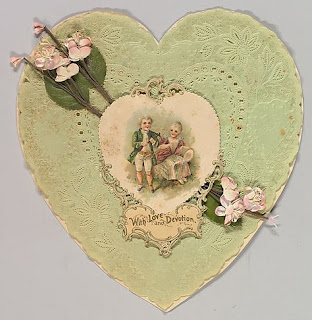Would your character have celebrated Valentine’s Day the way you are no doubt doing today? Let’s investigate the holiday and its celebrations during the days of the Old West.
People have observed St. Valentine’s Day for centuries. Famed London diarist Samuel Pepys mentioned observances in the 1600s, complete with elaborate gift-giving among the wealthier citizens. People began writing special notes and letters to observe the holiday around the 1700s, but papers made especially for Valentine’s Day weren’t marketed until 1820. These became popular both in England and the United States. The first valentines were flat sheets, often with colorful illustrations and embossed edges. The sheets could be folded, sealed with wax, and mailed.
According to legend, the American Valentine industry began in New England, when Esther A. Howland, from Worcester, Massachusetts, received an English Valentine’s Day card. She began making her own cards and, as her father ran a stationary store, began selling them there. Soon the demand had her recruiting friends to help make more cards, and as that demand grew, her hometown became the center of American Valentine production.
By 1856, the sending of manufactured cards was so popular that the New York Times published an editorial condemning the practice.
"Our beaux and belles are satisfied with a few miserable lines, neatly written upon fine paper, or else they purchase a printed Valentine with verses ready made, some of which are costly, and many of which are cheap and indecent.
"In any case, whether decent or indecent, they only please the silly and give the vicious an opportunity to develop their propensities, and place them, anonymously, before the comparatively virtuous. The custom with us has no useful feature, and the sooner it is abolished the better."
Despite the scathing article, the practice of sending Valentines continued to flourish throughout the mid-1800s. On February 4, 1867, the Superintendent of the Carrier Office of the New York Post Office, one J. H. Hallett, stated that in 1862, New York City Post Offices had accepted 21,260 Valentines for delivery. 1863 showed a slight increase, but in 1864, the number dropped to only 15,924. A huge change then occurred in 1865, perhaps because the dark years of the Civil War were ending. New Yorkers mailed more then 66,000 Valentines that year, and 86,000 in 1866.
In the late 1860s, most Valentines were modestly priced, and designed for a mass audience. Many were designed to be humorous, with caricatures of particular professions or ethnic groups. The sending of such joke cards became a fad during the late 1800s, although many serious cards were also sent.
New Yorkers sometimes paid exorbitant prices for a romantic card. An article explains that, in addition to beautiful paper scenes, “Receptacles cunningly prepared may hide watches or other jewelry, and, of course, there is no limit to the lengths to which wealthy and foolish lovers may go."
The legendary British illustrator of children’s books, Kate Greenway, designed enormously popular Valentines during the late 1800s. Some of her illustrations were collected in Quiver of Love: A Collection of Valentines, published in 1876 (link is to a free Google-Books copy).
Valentines typically portray Cupid, the Roman god of love, along with hearts, traditionally the seat of emotion. Because it was thought that birds began mating in mid-February, they, too, became a symbol of the day. Traditional gifts include candy and flowers, especially red roses, a symbol of beauty and love.
Does your character have a particular romantic interest they’d have sent a card or gift to? What about receiving a Valentine’s Day card? Or would they remain anonymous in both cases? Would they have sent a hand-penned letter or used a manufactured card? Whatever you decide, Valentine’s Day is a day to think about love and celebrate it (or bemoan its lack).
J.E.S. Hays
www.jeshays.com
www.facebook.com/JESHaysBooks





Shakespeare said it best - A pox on all their houses. Thanks for the laugh.
ReplyDeleteInformative and useful. I don't usually do much for the holiday, but authors, friends and co-workers seem to enjoy the day. Some even make their own cards, and of course the chocolate ...sigh. Thanks. Doris
ReplyDelete